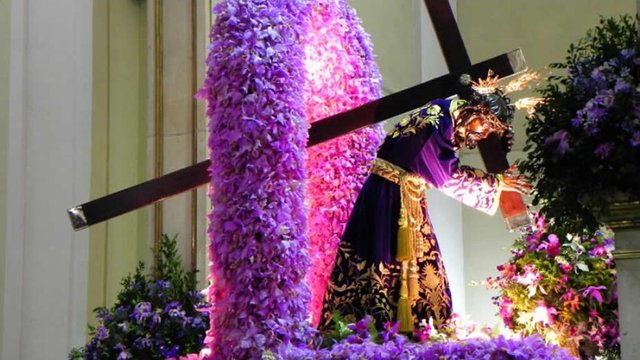The Nazareno de San Pablo is an advocation of Jesus Christ venerated in the city of Caracas, Venezuela. Nazareno is the gentilicio of the region of Galilea, locality where Jesus lived most of his life, after his birth in Bethlehem (Judea) and his childhood in Egypt.
The representations of Jesus with the cross on his back are called Nazarene, while the name of Christ is reserved for the images of Jesus already crucified. The Nazarene wears purple, then, in those years this color was identified with royalty.

FUENTE
The devotion dates from 1597 when the inhabitants of the whole country were affected by the plague of black vomit (known in our days as yellow fever). The inhabitants of Caracas asked the religious authorities to carry out a procession with the image through the few streets that Caracas had at that time.
Indeed, on Holy Wednesday the image came out in procession. Passing the corner of Miracielos, the procession was diverted a little to avoid a quagmire causing the crown, one of the hands of the Nazarene and an arm of the cross to be entangled with lemon tree loaded with fruit that jutted from the ground where it had been planted .

FUENTE
When they stumbled over the image, the lemons began to fall, which was interpreted by those present as a sign, they took the lemons and began to give it to the sick people who improved automatically. That was how the plague that had claimed so many lives ended.
Since then on Wednesday holy is dedicated to the worship of this image that year after year leaves in procession through the streets of the capital and has an impact on different populations of Venezuela.
It is the second largest religious manifestation in the country. The first is that of the Divina Pastora, held every January 14 in Lara State.

FUENTE
The image made in Flanders pine comes from Seville, Spain, and presumably was made by the sculptor Felipe de Rivas who took care of every detail and used characteristic features of Spanish art: the mouth ajar, expressive eyes and hands that look real. Its cross is hollow to avoid damage by weight in size.

FUENTE
The popular ideology tells the following legend: When the sculptor finished his wonderful work, he went to the wood carving to ask him: What do you lack my GOD ?, and the Nazarene replied, Where have you seen me how perfect you have made me? ?, immediately the artist died impressed.

FUENTE
For 1674 Caracas counted on only 3 churches, the archbishop of the city Fray Antonio González de Acuña received the image and arranged for it to rest in the temple of San Pablo el Ermitaño.

FUENTE
This revered image from Caracas was the reason for inspiration that in 1801, José Ángel Lamas composed the famed "Popule Meus".
In 1833 the Centaur of the Plains, José Antonio Páez, revealed to have been benefited with a miracle of the Nazarene of San Pablo, in gratitude for the favor granted purple dress every Wednesday holy for the remaining years of life. This act of the hero of the independence was taken as an example and is emulated until today by many Venezuelans.

FUENTE
Initially, the image rested in the church of San Pablo el Ermitaño, this temple was on the corner of El Silencio, site where the Municipal Theater of Caracas "Alfredo Sadel" is currently located.
It was for 200 years in this temple until in 1876 the construction of the Guzmán Blanco Theater began, renamed in 1888 as the Municipal Theater of Caracas.

FUENTE
Before the popular acclamation of a temple for the Nazarene after the demolition of the church of San Pablo el Ermitaño, the President of the Republic, Antonio Guzmán Blanco ordered the construction of the Basilica of Santa Teresa. All the objects of the demolished church were moved to the newly built church, losing 6 of the 7 tunics with which the Nazarene dressed.
It is the only religious image of the country and perhaps of the world to which an X-ray has been made. The findings of this procedure carried out in the mid-1990s indicated that there was great deterioration in the hair, hands and feet of the work and that it had been perforated by a firearm projectile at the height of the right cheek . The radiography was ordered by the Spanish Manolo Díaz who would be the restorer of the piece for decades.
The beautiful image has a special connection with the Venezuelan population, the legend says that the greater the suffering of the people and the more serious the economic situation of the country, the wood carving is stooping more and more in the same way as the coloring of its skin is becoming darker.
Poema "El Limonero del Señor", in the voice of its author, Andrés Eloy Blanco.
Who has not heard this song in the voice of Ismael Rivera?
Another less well-known song, also inspired by this tradition.
